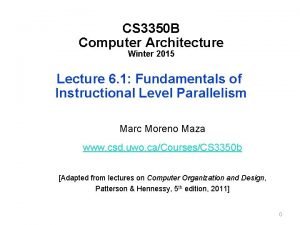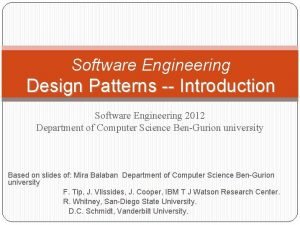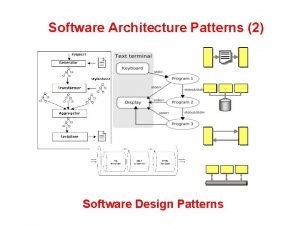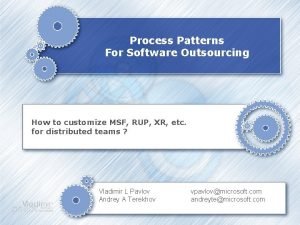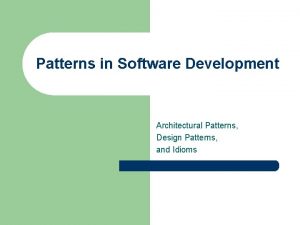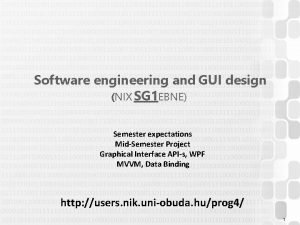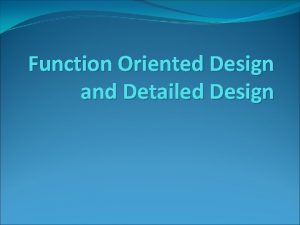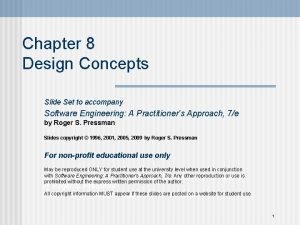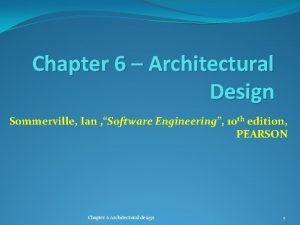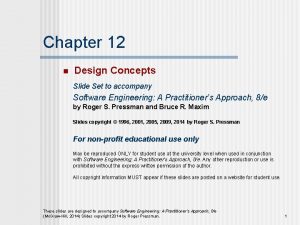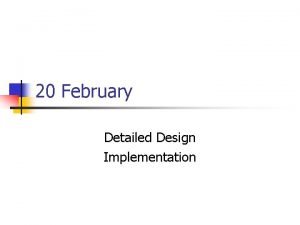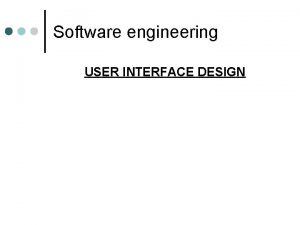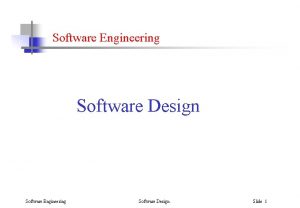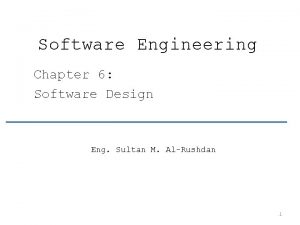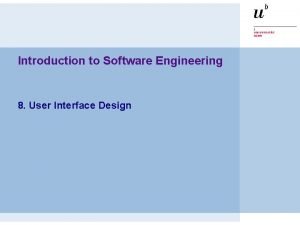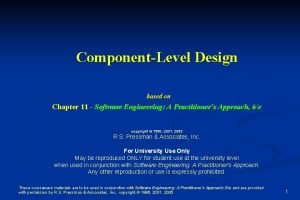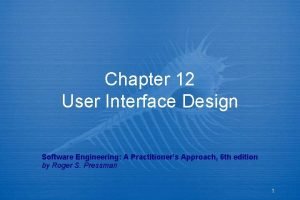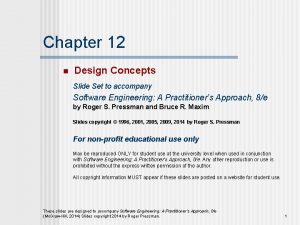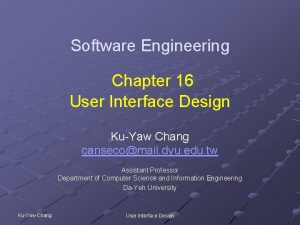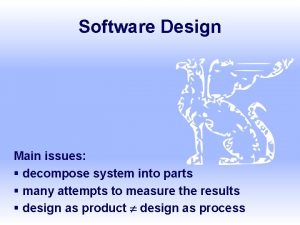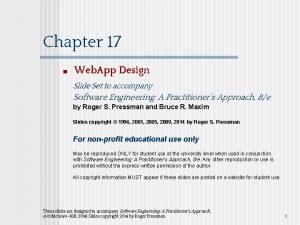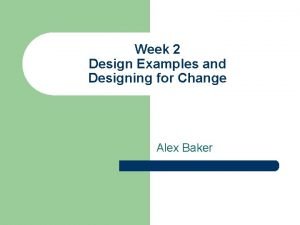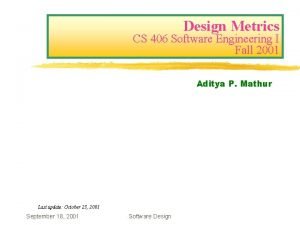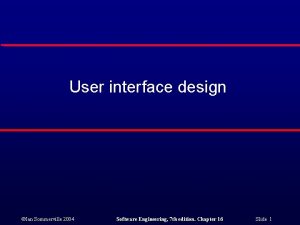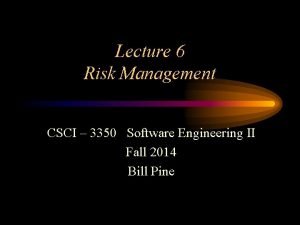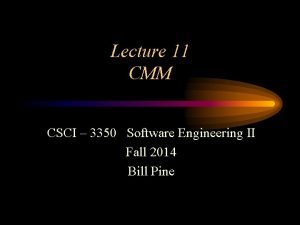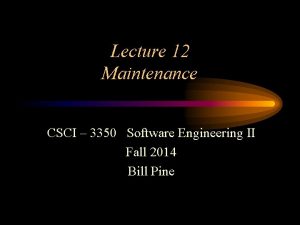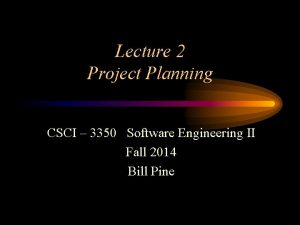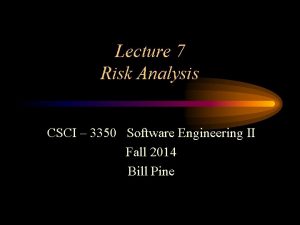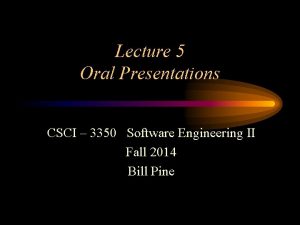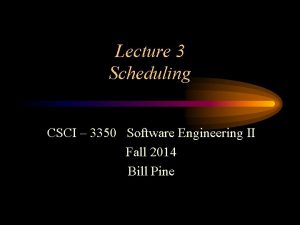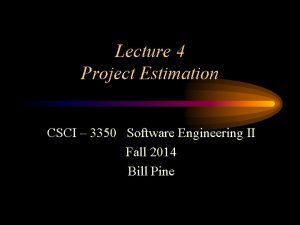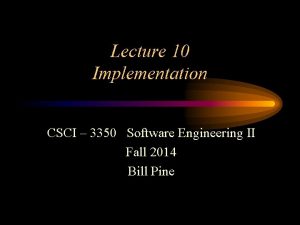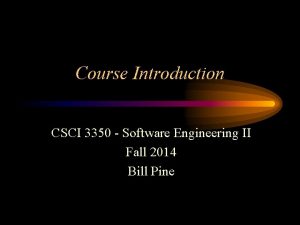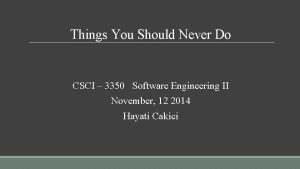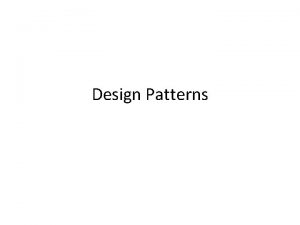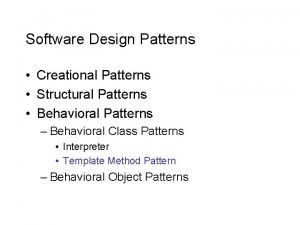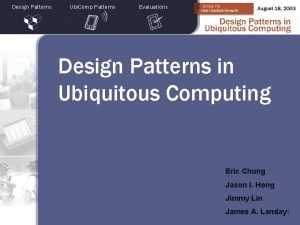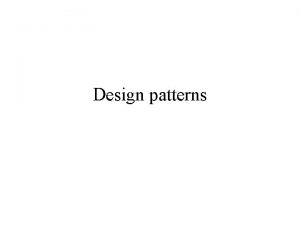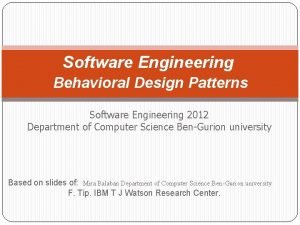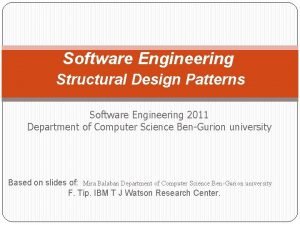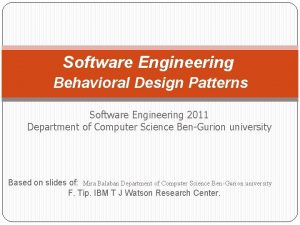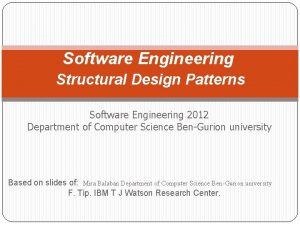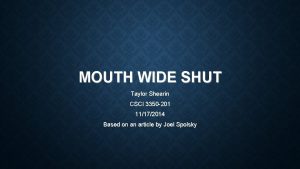Lecture 9 Design Patterns CSCI 3350 Software Engineering



































- Slides: 35

Lecture 9 Design Patterns CSCI – 3350 Software Engineering II Fall 2014 Bill Pine

Lecture Overview • • Background from architecture Basic design patterns Standard format Example patterns CSCI 3350 Lecture 9 - 2

Background • Recall the Chess Master Analogy • The Software Design Master – Must know, understand, and apply the deisgn patterns • There are hundreds of these patterns • The more frequently occurring patterns have been cataloged • We will examine a subset of these CSCI 3350 Lecture 9 - 3

Introduction • • Motivation: Promote reuse at design level An o-o system is an assembly of classes Want to leverage previous efforts New systems contain functionality not present in old – Else why build a new one? • Existing classes will likely be used in different ways than originally designed CSCI 3350 Lecture 9 - 4

Introduction (continued) • At least some of needed functionality will have been previously developed – Why re-invent the wheel? – Developing new implementations to familiar problems • Is a waste of time and money while under development • Serves as an injector of faults – And therefore a further waste of time and money • Design patterns are an attempt to provide a body of knowledge to commonly recurring problems – In a standard format CSCI 3350 Lecture 9 - 5

Introduction (continued) • The standard reference for object-oriented design patterns is the book – Title: Design Patterns: Elements of Reusable Object-Oriented Software – Authors: Erich Gamma, Richard Helm, Ralph Johnson, and John Vlissides – The authors are referred to as the “Gang of Four” in object-oriented design literature CSCI 3350 Lecture 9 - 6

Definition • Quote from Christopher Alexander “Each pattern describes a problem which occurs over and over again in our environment, and then describes the core of the solution to that problem, in such a way that you can use this solution a million times over, without ever doing it the same way twice. ” CSCI 3350 Lecture 9 - 7

Definition (continued) • What is the origin of design patterns? – Conventional architecture – Proposed by Christopher Alexander – The architectural patterns described towns and buildings • A pattern is a bit of insight that conveys the essence of a proven solution to a commonly recurring problem CSCI 3350 Lecture 9 - 8

Definition (continued) • An analogy from Jim Coplien “I could tell you how to make a dress by specifying the route of a pair of scissors through a piece of cloth, in terms of angles and length of cut. Or, I could give you a pattern. By reading the specification, you would have no idea of what was being built. The pattern foreshadows the product; it is the rule for making the thing, but it is also, in many respects, the thing itself. ” CSCI 3350 Lecture 9 - 9

Basic Design Patterns • Go. F describes 23 of the more commonly recurring patterns • The patterns are classified into three categories – Creational • Concerned with creating object • Object instantiation is deferred to a subclass – Structural • Concerned with the composition of classes or objects – Behavioral • How classes or object interact or distribute responsibility CSCI 3350 Lecture 9 - 10

Design Pattern Classification Purpose Creational Structural Behavioral Class Scope Factory Method Adapter(class) Interpreter Template Method Object Scope Abstract Factory Builder Prototype Singleton* Adapter* Bridge* Composite* Decorator Façade* Flyweight Proxy* Chain of Responsibility Command Iterator* Mediator Memento Observer* State Strategy Visitor CSCI 3350 Lecture 9 - 11

Standard Format • 13 section standard format – Pattern name and classification – Scope • Class – Deals with relationships between classes and their subclasses – Established through inheritance and are static – Fixed at compile time • Object – Deals with relationships between objects – Set or changed at runtime and are therefore dynamic CSCI 3350 Lecture 9 - 12

Standard Format (cont) – Category • Creational • Structural • Behavioral CSCI 3350 Lecture 9 - 13

Standard Format (continued) – Intent • What does the pattern do? • What problem is solved? – Also known as (optional) • Alternative names for the pattern – Motivation • A scenario that illustrates – The problem – How the pattern solves the problem CSCI 3350 Lecture 9 - 14

Standard Format (continued) – Applicability • To what situation can the pattern be applied? • A diagram of the classes involved – Uses OMT (Object Modeling Technique) not UML – Participants • Classes or objects involved – Collaborations • How the participants interact to carry out their responsibilities CSCI 3350 Lecture 9 - 15

Standard Format (continued) – Consequences • Trade-offs and results of using the pattern – Implementation • Pitfalls, hints, and techniques • Language-specific issues – Sample code • Code snippets to illustrate the pattern – Known uses • Examples of the pattern found in “real” systems CSCI 3350 Lecture 9 - 16

Standard Format (continued) – Related Patterns • Closely related patterns and differences among patterns • When studying a design pattern, I find it helpful to begin with – Intent – Applicability – Known uses – Motivation CSCI 3350 Lecture 9 - 17

Singleton (Object – Creational) • Intent – To ensure that a class has only 1 instance – Provide a single point of access to the instance • Applicability – Use the Singleton pattern when: • There must be exactly 1 instance of a class • That instance must be accessible to all from 1 point CSCI 3350 Lecture 9 - 18

Singleton (continued) • Known uses – Smalltalk only examples supplied by Gamma • Motivation – To avoid conflicts, it is critical that some classes have only 1 instance • A file system that is a class within an operating system CSCI 3350 Lecture 9 - 19

Class Exercise • Produce a list of classes that might be used to create a graph of the type shown – Your design should be highly modular • Each aspect of the graph must be modeled as a separate class – The actual “drawing” will be achieved by calling a low level class Plot, whose specification is supplied CSCI 3350 Lecture 9 - 20

Façade (Object-Structural) • Intent – Provide a unified interface to a set of interfaces – Define a higher-level interface that make the underlying functionality easier to use • Applicability – You need to provide a simple interface to a complex subsystem • Many users don’t need the flexibility of the subsystem • All that flexibility is difficult to manage • Provide a default view of the subsystem CSCI 3350 Lecture 9 - 21

Façade (continued) • Known uses – Compilers • Suppose you want to compile a single line • Don’t need the hassle of calling the scanner, parse tree generator, optimizer, code generator • Provide a simple interface with defaults • Motivation – Structure a system into a subsystem to manage complexity – Shield the client from complex interfaces CSCI 3350 Lecture 9 - 22

Observer (Object-Behavioral) • Intent – Define a one-to-many dependency between objects so all dependents of an object are notified when the primary object changes state • Applicability – When an object’s state changes, with this change causing changes in other objects, but the changing object doesn’t know how many dependant objects there are CSCI 3350 Lecture 9 - 23

Observer (continued) • Known uses – Model / View / Controller • Controller gets user inputs and sends message to model • Model performs its calculations • View displays the model’s state, when notified by subscribe/notify protocol • Motivation – Create a loose coupling between the objects involved CSCI 3350 Lecture 9 - 24

Proxy (Object-Structural) • Intent – To provide a placeholder for another object • Applicability – When you need a more versatile reference than a pointer – Client sends messages to the proxy – Proxy provides additional services • Security • Data validation – Can be used to delay server request until really needed CSCI 3350 Lecture 9 - 25

Proxy (continued) • Known uses – Instead of inserting a complex graphic into a document, insert a proxy – The proxy will load the real graphic when needed • Motivation – When you need to enhance a server – Postpone an activity until it is needed CSCI 3350 Lecture 9 - 26

Composite (Object-Structural) • Intent – Decompose objects into tree structures that represent a part/whole hierarchy • Applicability – When you need to represent whole/part relationship – When you want to treat objects and composition of objects equivalently CSCI 3350 Lecture 9 - 27

Composite (continued) • Known uses – File systems consist of • Directories • Files • But directories can hold files and other directories – Composite drawings • Motivation – Provide a uniform treatment of objects and composites of objects CSCI 3350 Lecture 9 - 28

Adapter (Object-Structural) • Intent – Convert the interface of a class into another interface more convenient for the client • Applicability – When you want to use an existing class, but the interface doesn’t match the one you need – Need to use several classes, each with different interfaces CSCI 3350 Lecture 9 - 29

Adapter (continued) • Known uses – Suppose you have a Windows application that uses the Windows file system – You need to run the application under UNIX – Write an adapter that accepts Windows file system calls and in turn makes the appropriate UNIX file system calls • Motivation – You have existing classes that provide the services you need, but not the interface CSCI 3350 Lecture 9 - 30

Bridge (Object-Structural) • Intent – Decouple an abstraction from its implementation to allow the two to vary independently • Want to provide the capability to run an application on multiple platforms • Applicability – When you want changes in the implementation to not affect their clients – When you want to hide the implementation from a client • C++ (unfortunately) refers to this as a proxy class CSCI 3350 Lecture 9 - 31

Bridge (continued) • Known uses – Isolate graphic clients from the hardware –UNIX – Isolate clients using windowing from platform specifics • Motivation – Isolate client abstractions from their implementation – Difference between Bridge and Adapter? • The Adapter is used for existing client code • The Bridge is an integral part of the initial design CSCI 3350 Lecture 9 - 32

Iterator (Object-Behavioral) • Intent – Provide a means of accessing the elements of an aggregate structure, sequentially, without exposing the underlying structure • Applicability – To provide access without knowledge of the internals of the structure – To support multiple access to the object – To provide a means of traversal that is uniform across all aggregate structures CSCI 3350 Lecture 9 - 33

Iterator (continued) • Known uses – Java • For each loop – Standard Template Library (C++) • Iterator class • Motivation – Isolate the structure from the means of traversing CSCI 3350 Lecture 9 - 34

Summary • This has been only a brief introduction to design patterns • Recall directive from the opening analogy – These designs contain patterns that must be • Understood • Memorized • Applied repeatedly • At best you have only begun step 1 CSCI 3350 Lecture 9 - 35
 Cs 3350
Cs 3350 Design patterns software engineering
Design patterns software engineering Real time software design in software engineering
Real time software design in software engineering Software design fundamentals in software engineering
Software design fundamentals in software engineering Requirement analysis in software engineering notes
Requirement analysis in software engineering notes Architectural pattern in software engineering
Architectural pattern in software engineering Process patterns in software engineering
Process patterns in software engineering Architectural patterns in software engineering
Architectural patterns in software engineering 01:640:244 lecture notes - lecture 15: plat, idah, farad
01:640:244 lecture notes - lecture 15: plat, idah, farad Computer based system engineering in software engineering
Computer based system engineering in software engineering Forward engineering and reverse engineering
Forward engineering and reverse engineering Software maintenance process models ppt
Software maintenance process models ppt Frank maurer
Frank maurer Metrics computer science
Metrics computer science Software engineering crisis
Software engineering crisis What is software measurement
What is software measurement User interface in software engineering
User interface in software engineering Nix gui
Nix gui Function oriented design
Function oriented design Design concepts in software engineering
Design concepts in software engineering Architectural design in software engineering
Architectural design in software engineering Design principles in software engineering
Design principles in software engineering Detailed design in software engineering
Detailed design in software engineering User interface software engineering
User interface software engineering Slidetodoc
Slidetodoc Pseudocode examples
Pseudocode examples User interface design principles in software engineering
User interface design principles in software engineering Component-level design in software engineering
Component-level design in software engineering User interface design process in software engineering
User interface design process in software engineering Design concepts in software engineering
Design concepts in software engineering Interface design in software engineering
Interface design in software engineering Design issues in software engineering
Design issues in software engineering Webapp design pyramid contains
Webapp design pyramid contains Design for change in software engineering
Design for change in software engineering Design metrics in software engineering
Design metrics in software engineering User interface design process in software engineering
User interface design process in software engineering
